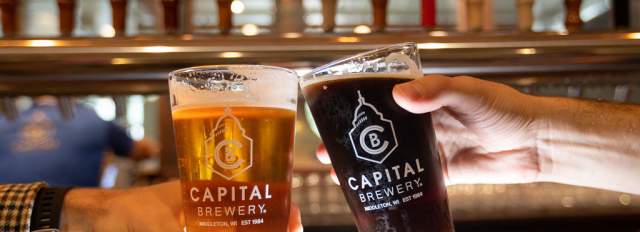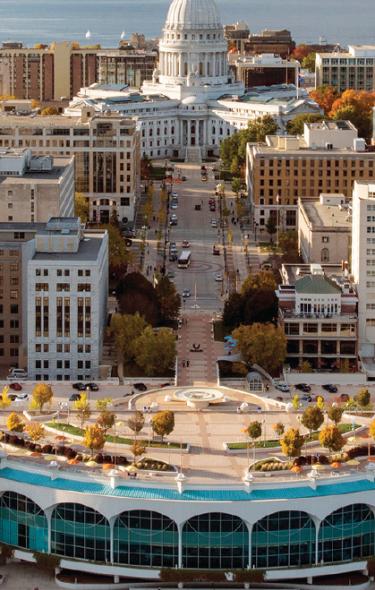Madison's lineup of celebrity chefs is a decorated group including culinary heavyweights like Odessa Piper, Tory Miller, Dan Fox, Andrew Kroeger and Itaru Nagano. Before these chefs could make their mark, one man blazed the trail for them: Madison's first celebrity chef, Carson Gulley.
That wasn't the only thing Gulley was first at. He and his wife were the first Black people to host a TV show in Wisconsin. He was among the first Black instructors at UW-Madison and the first Black person to have a UW building named after him.
Madison's reputation for farm-fresh, elevated and world-class food goes back decades to this man whose life started as a sharecropper and ended having influenced thousands of people through his signature dishes.
Gulley's TV legacy continued on season 21 of Bravo's Top Chef where the Cheftestants were tasked with using ingredients from the Dane County Farmers' Market to make sauces from Gulley's cookbook. You can see the chef's creations and learn more about Gulley by streaming the full episode now on Peacock.
Who was Carson Gulley?
Gulley's Madison legacy began in 1926 after the then-director of UW Housing discovered Gulley's food at a restaurant in Tomahawk. Gulley and the UW director Donald L. Halverson bonded over Halverson's first meal so well that they went fishing together the next day. Soon after, he was hired as the head chef at UW-Madison where he served from 1926 to 1954. His role at UW went beyond head chef. He often served as a consultant and teacher as well.
During World War II, Gulley became a leader for chefs at the Tuskegee Institute, a historically Black college that was home to many historical icons including the Tuskegee Airmen. It's where Gulley met Tuskegee icon George Washington Carver, who considered Gulley "an artist."
Gulley's fame reached new heights in the 1950s when he and his wife Beatrice Russey began hosting the twice-weekly "Cooking School of the Air" radio show and the "What's Cookin'" TV show on WMTV, now known as WMTV 15 News. Gulley and Russey were the first Black people to host a TV show in Wisconsin and their show was on air well before Julia Child's "The Best Chef" which aired in 1963 and is considered to be the catalyst for modern TV cooking shows.
Outside of the kitchen, Gulley left a mark on Madison in his fight for homeownership. After decades of being denied real estate in the city based on his race, Gulley petitioned the city to build a house on a lot in the Crestwood neighborhood. He was eventually approved to build the home, but the vote was met with much contention from community members.
Gulley died in 1962 at the age of 65. The UW Board of Regents voted unanimously three years later to rename Van Hise Commons to Carson Gulley Commons.
How can I experience Gulley's legacy in Madison?
One of Gulley's most famous credits is in a beloved UW-Madison sweet treat: the fudge-bottom pie. Some uncertainty swirls around who officially created the pie recipe, but Gulley claimed it in his cookbook. You can pre-order fudge-bottom pies with at least 72 hours notice from the Daily Scoop at Memorial Union or as part of a Wisconsin Union catering order. You can place orders at the Daily Scoop at (608) 262-5959, and Wisconsin Union catering can be reached at events@union.wisc.edu or (608) 262-2511.
The Carson Gulley Center remains today as a community center for Slichter, Adams and Tripp residence halls. Carson's Market, a small dining hall inside the Carson Gulley Center, is open to the public for all-you-can-eat service.
For golfers, enjoy one of Gulley's favorite pastimes at The Glen Golf Park where Gulley once shot a hole-in-one and where he is buried nearby.
How can I get a taste of Carson Gulley's recipes?
Gulley's cookbook "Seasoning Secrets and Favorite Recipes of Carson Gulley" and other recipes are maintained by UW-Madison in its online archives and are available for public viewing. Two of his most iconic recipes are below.
Carson Gulley's Own Method for Baked Beans
Gulley was known to be especially proud of his baked bean recipe, which is as follows.
-
1.5 pounds of dry navy beans
-
1 cup tomato puree
-
Half cup of brown and white sugar combined (two-thirds brown)
-
1 tablespoon of dry mustard
-
Half cup of fine-cut onion
-
1 teaspoon savory
-
2 teaspoons salt
-
Half-pound of diced salt pork
-
4 cups of water
Wash beans, soak overnight. Combine puree, sugar, mustard, salt, onion, savory and water. Heat together until boiling. Place diced salt pork in 3-quart bean pot; add beans. Pour in tomato mix and add water to about two inches above beans. Cover and cook in the oven at simmering temperature or about 250 degrees Fahrenheit, overnight or at least 12 to 18 hours. If oven gets hotter during that time, it may be necessary to add more water. Watch to see if the underside of the lid becomes darkened or burned. If so, when steam condenses on the lid it will cause the beans to become strong flavored and taste burned. Therefore, any signs of burn on the lid should be cleaned off.
Barbecue Sauce
Sauces were a specialty of Gulley's, particularly his barbecue sauce.
-
4 tablespoons butter or good fat
-
One-quarter cup onion, finely chopped
-
1.5 teaspoons of white pepper
-
2 tablespoons of sugar
-
2 tablespoons of celery salt
-
4 teaspoons of paprika
-
3 tablespoons of garlic vinegar
-
3 cups seasoned stock*
-
1 teaspoon Tabasco sauce
-
2 tablespoons Worcestershire sauce
-
1 and one-third cups of chili sauce
Saute onions in butter until tender. Add all dry ingredients, then liquid ingredients. Boil slowly for one hour. Pour over meat. Heat in oven at low temperature for 30 minutes or more.
*If this sauce is to be kept for any length of time, use bouillon cubes dissolved in hot water instead of meat stock.











